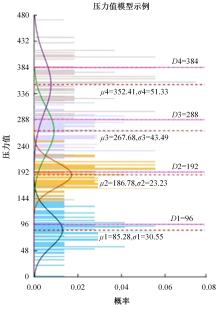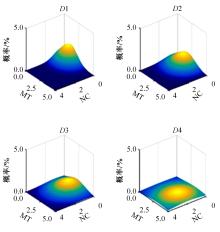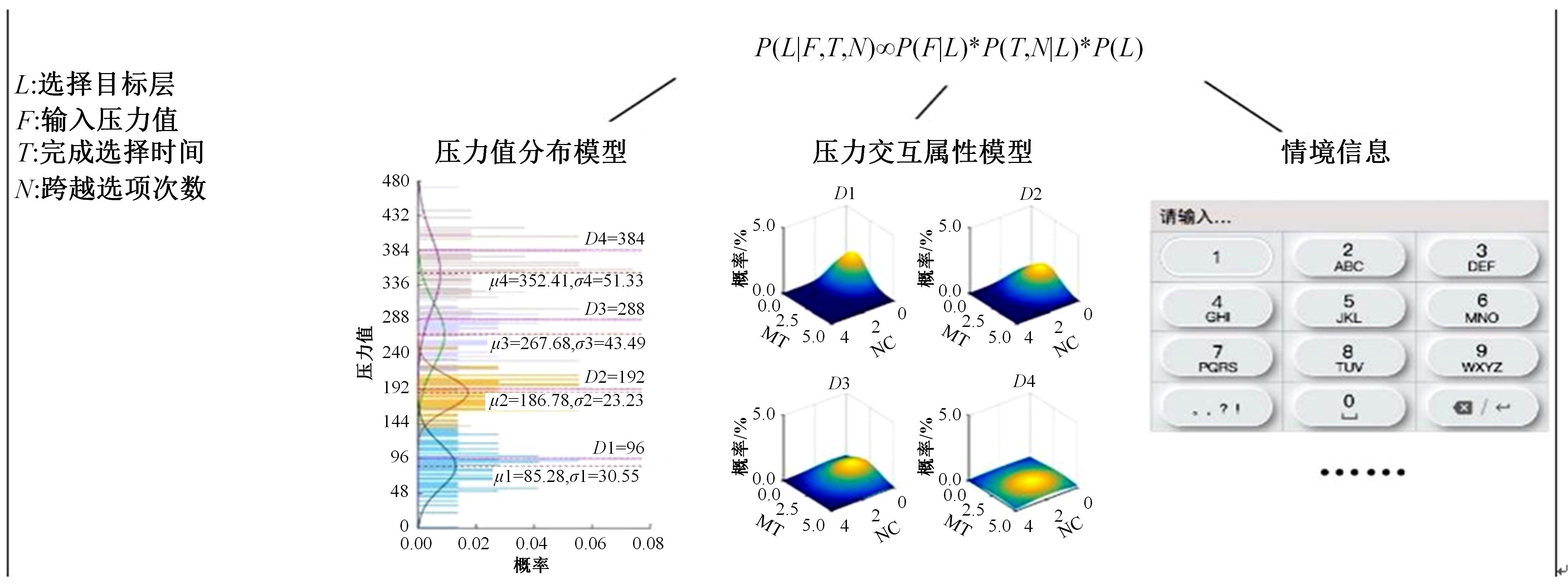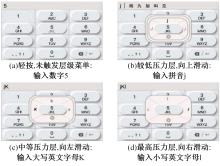吉林大学学报(工学版) ›› 2023, Vol. 53 ›› Issue (11): 3186-3193.doi: 10.13229/j.cnki.jdxbgxb.20220036
多媒体终端上新型压力交互范式研究
- 1.吉林大学 计算机科学与技术学院,长春 130012
2.吉林大学 符号计算与知识工程教育部重点实验室,长春 130012
3.一汽大众汽车有限公司,长春 130011
Research on a pressure-based interaction paradigm for multimedia terminal
Gui-he QIN1,2( ),Man-ying WANG3,Ming-hui SUN1,2(
),Man-ying WANG3,Ming-hui SUN1,2( )
)
- 1.Collage of Computer Science and Technology,Jilin University,Changchun 130012,China
2.Key Laboratory of Symbolic Computation and Knowledge Engineering of Ministry of Education,Jilin University,Changchun 130012,China
3.FAW-Volkswagen Automotive Company Ltd. ,Changchun 130011,China
摘要:
针对移动终端上压力交互提出一种新型界面范式LWHP,并通过Bayes方法推理用户交互意图,优化压力空间划分。LWHP范式采用三维办公桌隐喻,包含图层(Layer),部件(Widget)、层级菜单(Hierarchical Menu)和压力手势(Pressure+Gesture)4个组成要素。基于用户历史输入的Bayes层级菜单分层优化算法,结合压力信号、交互特征(时间和跨越选项次数)和情境信息对用户意图分析解释,优化压力空间划分方式,提高交互准确性和自然性。最后,通过一个基于LWHP范式的相册交互场景阐述其应用和相关部件设计。
中图分类号:
- TP37
| 1 | 许为. 再论以用户为中心的设计: 新挑战和新机遇[J]. 人类工效学, 2017, 23(1): 82-86. |
| Xu Wei. User-centered design(Ⅱ): new challenges and new chances[J]. Chinese Journal of Ergonomics, 2017, 23(1): 82-86. | |
| 2 | 范俊君, 田丰, 杜一, 等. 智能时代人机交互的一些思考[J]. 中国科学: 信息科学, 2018, 48(4): 361-375. |
| Fan Jun-jun, Tian Feng, Du Yi, et al. Thoughts on human-computer interaction in the age of artificial intelligence[J]. Sci Sin Inform, 2018, 48(4): 361-375. | |
| 3 | Corsten C, Lahaye M, Borchers J, et al. ForceRay: extending thumb reach via force input stabilizes device grip for mobile touch input[C]∥Proceedings of the 2019 CHI Conference on Human Factors in Computing Systems, Glasgow, UK, 2019: 1-12. |
| 4 | Hakka K, Isomoto T, Shizuki B. One-handed interaction technique for single-touch gesture input on large smartphones[C]∥Symposium on Spatial User Interaction, New Orleans, USA, 2019: 1-2. |
| 5 | Corsten C, Voelker S, Link A, et al. Use the force picker, luke: space-efficient value input on force-sensitive mobile touchscreens[C]∥Proceedings of the 2018 CHI Conference on Human Factors in Computing Systems, Montreal, Canada, 2018: 1-12. |
| 6 | Lumsden J, Brewster S. A paradigm shift for mobile interaction: a decade later[C]∥Proceedings of the 2013 Conference of the Center for Advanced Studies on Collaborative Research, Toronto, Canada, 2013: 2-9. |
| 7 | Brewster S A, Hughes M. Pressure-based text entry for mobile devices[C]∥Proceedings of the 11th International Conference on Human-Computer Interaction with Mobile Devices and Services, Bonn, Germany, 2009: 1-4. |
| 8 | Hsiu M C, Huang D Y, Chen C, et al. ForceBoard: using force as input technique on size-limited soft keyboard[C]∥Proceedings of the 18th International Conference on Human-Computer Interaction with Mobile Devices and Services Adjunct, Florence, Italy, 2016: 599-604. |
| 9 | Green M, Jacob R. SIGGRAPH'90 workshop report: software architectures and metaphors for non-WIMP user interfaces[J]. ACM SIGGRAPH Computer Graphics, 1991, 25(3): 229-235. |
| 10 | Dam A V. Post-WIMP user interfaces[J]. Communications of the ACM, 1997, 40(2): 63-67. |
| 11 | Jacob R J K, Girouard A, Hirshfield L M, et al. Reality-based interaction: a framework for post-WIMP interfaces[C]∥Proceedings of the SIGCHI Conference on Human Factors in Computing Systems, Toronto, Canada, 2008: 201-210. |
| 12 | 石磊, 邓昌智, 戴国忠. 一种 Post-WIMP 界面: PGIS 的实现[J]. 中国图象图形学报, 2010, 15(7): 985-992. |
| Shi Lei, Deng Chang-zhi, Dai Guo-zhong. Implementation of PGIS: a type of post-WIMP user interface[J]. Journal of Image and Graphics, 2010, 15(7): 985-992. | |
| 13 | Robbins D C, Lee B, Fernandez R. TapGlance: designing a unified smartphone interface[C]∥Proceedings of the 7th ACM conference on Designing interactive systems, Cape Town, South Africa, 2008: 386-394. |
| 14 | 张小龙, 吕菲, 程时伟. 智能时代的人机交互范式[J]. 中国科学: 信息科学, 2018, 48: 406-418. |
| Zhang Xiao-long, Fei Lyu, Cheng Shi-wei. Interaction paradigm in intelligent systems[J]. Sci Sin Inform, 2018, 48: 406-418. | |
| 15 | Kay M, Nelson G L, Hekler E B. Researcher-centered design of statistics: why Bayesian statistics better fit the culture and incentives of HCI[C]∥Proceedings of the 2016 CHI Conference on Human Factors in Computing Systems, San Jose, USA, 2016: 4521-4532. |
| 16 | 王利民,刘洋,孙铭会,等. 基于Markov blanket的无约束型K阶贝叶斯集成分类模型[J]. 吉林大学学报: 工学版, 2018, 48(6): 1851-1858. |
| Wang Li-min, Liu Yang, Sun Ming-hui, et al. Ensemble of unrestricted K-dependence Bayesian classifiers based on Markov blanket[J]. Journal of Jilin University(Engineering and Technology Edition), 2018, 48(6): 1851-1858. | |
| 17 | Goodman J, Venolia G, Steury K, et al. Language modeling for soft keyboards[C]∥Proceedings of the 7th International Conference on Intelligent User Interfaces, San Francisco, USA, 2002: 194-195. |
| 18 | Yu C, Sun K, Zhong M, et al. One-dimensional handwriting: inputting letters and words on smart glasses[C]∥Proceedings of the 2016 CHI Conference on Human Factors in Computing Systems, San Jose, USA, 2016: 71-82. |
| 19 | 秦贵和,黄俊锋,孙铭会. 基于双手键盘的虚拟现实文本输入[J]. 吉林大学学报: 工学版, 2022, 52(8): 1881-1888. |
| Qin Gui-he, Huang Jun-feng, Sun Ming-hui. Text input based on two-handed keyboard in virtual environment[J]. Journal of Jilin University(Engineering and Technology Edition), 2022, 52(8): 1881-1888. | |
| 20 | 易鑫, 喻纯, 史元春. 普适计算环境中用户意图推理的 Bayes 方法[J]. 中国科学: 信息科学, 2018, 48: 419-432. |
| Yi Xin, Yu Chun, Shi Yuan-chun. Bayesian method for intent prediction in pervasive computing environments[J]. Sci Sin Inform, 2018, 48: 419-432. | |
| 21 | Ramos G, Boulos M, Balakrishnan R. Pressure widgets[C]∥Proceedings of the SIGCHI Conference on Human Factors in Computing Systems, Toronto, Canada, 2004: 487-494. |
| 22 | 文涛, 李雪, 李晟, 等. 手机输入法可用性评估研究[J]. 人类工效学, 2012, 18(2): 27-31. |
| Wen Tao, Li Xue, Li Sheng, et al. Usability evaluation of input methods in mobile phone[J]. Chinese Journal of Ergonomics, 2012, 18(2): 27-31. | |
| 23 | Wang F, Ren X. Empirical evaluation for finger input properties in multi-touch interaction[C]∥Proceedings of the SIGCHI Conference on Human Factors in Computing Systems, Toronto, Canada, 2009: 1063-1072. |
| [1] | 张惠,聂志玲,肖宏伟,王聃星. 无人驾驶汽车智能座舱人机交互界面色彩设计[J]. 吉林大学学报(工学版), 2023, 53(5): 1315-1321. |
| [2] | 孙舒杨,程玮斌,张浩桢,邓向萍,齐红. 基于深度学习的两阶段实时显式拓扑优化方法[J]. 吉林大学学报(工学版), 2023, 53(10): 2942-2951. |
| [3] | 秦贵和,黄俊锋,孙铭会. 基于双手键盘的虚拟现实文本输入[J]. 吉林大学学报(工学版), 2022, 52(8): 1881-1888. |
| [4] | 李学勇,赵仲秋,张春松,路长厚. 基于有限元的人体⁃机械手交互力计算方法[J]. 吉林大学学报(工学版), 2021, 51(5): 1612-1619. |
| [5] | 刘元宁,吴迪,朱晓冬,张齐贤,李双双,郭书君,王超. 基于YOLOv3改进的用户界面组件检测算法[J]. 吉林大学学报(工学版), 2021, 51(3): 1026-1033. |
| [6] | 管乃彦,郭娟利. 基于姿态估计算法的组件感知自适应模型[J]. 吉林大学学报(工学版), 2020, 50(5): 1850-1855. |
| [7] | 孟书, 申桂香, 张英芝, 龙哲, 曾文彬. 基于时间相关的数控机床系统组件更换时间[J]. 吉林大学学报(工学版), 2016, 46(6): 1946-1952. |
| [8] | 赵伟, 曲慧雁. 基于云计算Map-Reduce模型的快速碰撞检测算法[J]. 吉林大学学报(工学版), 2016, 46(2): 578-584. |
| [9] | 董立岩, 高洋, 李永丽, 任时鸣. 一种基于网格采样的手势识别算法[J]. 吉林大学学报(工学版), 2013, 43(06): 1621-1625. |
| [10] | 曹晓宁, 刘玉梅, 苏建, 王秀刚, 李卓. 转向架质心高度的测定[J]. 吉林大学学报(工学版), 2013, 43(02): 329-333. |
| [11] | 冯铁, 柴胜, 张家晨, 冉宏敏. 一种软件体系结构动态变动影响分析方法[J]. 吉林大学学报(工学版), 2011, 41(02): 458-0462. |
| [12] | 秦进,史峰,邓连波,肖龙文. 道路交通网络效率定量评价方法及其应用[J]. 吉林大学学报(工学版), 2010, 40(01): 47-0051. |
| [13] | 郭孔辉;吕济明;丁海涛;郭文鑫. 基于MATLAB的车辆组件模型库的设计与实现[J]. 吉林大学学报(工学版), 2006, 36(06): 866-0870. |
| [14] | 刘萍萍, 周求湛, 徐昊, 申铉京. 混合型分布式入侵检测系统模型[J]. 吉林大学学报(工学版), 2004, (4): 666-670. |
|







